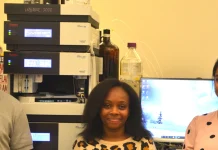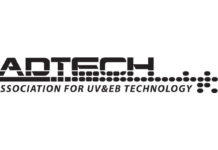By Susan E. Bailey, Ph.D., technical manager – North America, IGM Resins
 UV and EB formulations convert under radiation exposure from a liquid composition to a solid material. The compositions can be complex mixtures. Any components that do not react to incorporate into the polymer network are trapped within it; however, they have the potential to migrate from the coating with exposure to heat, contact with similar materials or over time. Even though these components are minute constituents of the final film, they can affect the coating performance and that of the coated product. In certain applications, the chemicals released are regulated and need to be strictly controlled. A concerted strategy of raw material selection and characterization of product performance under life cycle conditions should be used to achieve the desired low migration outcome.
UV and EB formulations convert under radiation exposure from a liquid composition to a solid material. The compositions can be complex mixtures. Any components that do not react to incorporate into the polymer network are trapped within it; however, they have the potential to migrate from the coating with exposure to heat, contact with similar materials or over time. Even though these components are minute constituents of the final film, they can affect the coating performance and that of the coated product. In certain applications, the chemicals released are regulated and need to be strictly controlled. A concerted strategy of raw material selection and characterization of product performance under life cycle conditions should be used to achieve the desired low migration outcome.
First, consider the components that can migrate. After the cure reaction, many components are chemically bound. Residual monomer and photoinitiator molecules remain unbound in the coating. Formulation additives that are not intended to participate in the polymerization are also unbound. Many formulation components will contain stabilizers, as well as residual components of their own synthetic manufacture.

Migration can occur through a few basic mechanisms. The most common mechanisms that affect food packaging are outlined in Table 1.
The migrating species can penetrate into the substrate that was coated. An example of this is the diffusion of migrating components into the substrate leading to embrittlement of the coating. The porosity of the substrate, as well as the similarity between the substrate and the coating components, can influence this migration. Migration also can occur during direct contact of a new surface and the radiation-cured coating. An example of the effect is the transfer of migrating species into food products that can occur when this contact is made between the printed and nonprinted side of food packaging. Migration of residual components from the coating surface into the new substrate tends to drive this process that is typically dependent on the time of contact. Elevated temperature product use environments lead to the evaporation of volatile residual components and migration to the coating surface. External heat examples include boil-in-bag food packaging and sterilization processes.
Migrating species are controlled by regulation from several directions. In the application example of food packaging, the US Food and Drug Administration (FDA) Code of Federal Regulations (CFR) Title 21 parts 170-199 in particular chapters 175.300, 175.320, 176.170 and 176.180 are applicable. Evidence for low risk of food contamination is established by extensive characterization of the product (the printed and converted package) during the intended use. An example of this process for radiation-cured materials is Food Contact Notification (FCN) 772. The European regulations that control migration of substances into food include Framework Regulation (EC) No 1935/2004 and EU Regulation (EC) No 10/2011. The first defines prohibited migration into food products while the second assigns specific migration limits (SML). The “Ordinance of the FDHA on Materials and Articles (817.023.21) is the implementation by Switzerland commonly known as the Swiss Ordinance List. The ordinance list consists of several annex documents. For food packaging, Annex 6 is applicable. Annex 6 is a positive list for all other substances used in food packaging and is divided in two parts. Part A lists substances that are evaluated and can be used for printing inks. Many materials will have an SML (mg/kg) reported for maximum migration. For the materials on the Part A list without an SML, then a migration maximum of 60 mg/kg is set. Part B lists non-evaluated substances. These materials can be used in food packaging as long as transfer of these substances to food or food simulants is not detected. The detection limit cannot exceed 0.01 mg/kg (10 ppb).
Nestlé Guidance Note on Packaging Inks (February 2014) is an initiative on packaging safety and compliance. The document applies to printing inks, lacquers, coatings and varnishes. As a rule, only ink ingredients listed on the Swiss ordinance list can be used, with the migration-maximum mentioned in the A list. For the B list, the detection limit cannot exceed 0.01 mg/kg (10 ppb). The Nestlé guidance note is an additional list of components, registered on the Swiss Ordinance list, that must be excluded from ink formulations.
Raw Material Selection Strategies

Photoinitators present migrating species in the cured product both as residual unreacted material as well as side products formed during the cure reaction. A structure commercially available that addresses both incorporation and elimination of odorous side products is an oligomeric polyfunctional a hydroxyketone photoinitiator. The oligomer is of high molecular weight compared to the standard monomeric a hydroxyketone photoinitiator. There are multiple photoreactive radical forming moieties per molecule. In addition, it can generate radicals both by a-cleavage with formation of the benzyl radical and by hydrogen transfer with the formation of a ketyl radical. The structure of oligomeric polyfunctional a hydroxyketone photoinitiator is shown in the Figure 1.
The attachment of the photoreactive species along the backbone prohibits the formation of aromatic aldehydic compounds during the cure reaction. In the FCN 722, the purified dimer, Esacure One, has been used to demonstrate radiation curing in a food contact application.
Polymeric photoinitiators can also be based on linear structures where photoreactive moieties are attached to the end(s) of polymeric backbones.
This type of structure gives rise to very viscous products that have low migration potential due to both their relatively high molecular weight and ability of the photoreactive ends to incorporate into the growing polymer, effectively crosslinking the photoinitiator in the network. A variety of linear high molecular weight polymeric photoinitiators (both Type I and Type II) are commercially available, along with amine synergists. These items together help to create a greater formulation latitude.

A common challenge in food packaging is the requirement for a coating to remain flexible in addition to limiting the migrating components. Outside of the migration requirement, formulations for flexibility include the use of monofunctional monomer. Partially reacted multifunctional monomers are chemically bound in the coating polymer matrix, while – due to their single reaction point – monofunctional monomers are chemically bound or are free to migrate after cure. For this reason, monofunctional monomers are typically excluded, even in low percentages, from low migration applications. However low migration strategies for highly functional monomers can reduce the coating flexibility through increased crosslink density and shrinkage upon curing. Use of ethoxylated and propoxylated versions of highly functional monomers can allow for greater flexibility while maintaining the desired functionality. The greater molecular weight and nature of the group incorporated also can have beneficial impact to the migration and organoleptic properties.
Many of the acrylate monomers and oligomers in the industrial sector are produced using the standard solvent esterification process. This process uses toluene and/or cyclohexane, and residual amounts of solvent are present in the final product. The residual content is typically at low levels (<5000 ppm), even for industrial uses. Materials recommended for low-migration applications undergo additional processing/stripping steps to reduce the residual solvent to very low levels (<5 ppm).
Radiation-cured inks and coatings provide a wide toolbox to the formulator to tailor the liquid formulation for application technique while maintaining the target cured properties as well. Selection of photoinitiators, monomers, oligomers and the curing radiation should work together to incorporate or confine the components in the coating after the cure process is completed.
It is important for everyone in the value chain to remember that low-migration applications require a concerted strategy that includes the raw material selection as well as the ink formulation, cure conditions and intended product use environment. Guidelines and recommendations should be applied to each component of composite packaging materials. Migration data should be generated under realistic and practical conditions by accepted analytical methods, as the nature of substrates, packaging contents and converter operations conditions can be diverse.
It is ultimately the responsibility of the packaging designer, the printer that manufactures the packaging and the distributor of the product to ensure that the packaging produced meets requirements of the regulations. Advice and guidance on selection of appropriate materials for the end use of the packaging is available from raw material suppliers and trade associations to help ensure compliance.
Acknowledgments: Tracey Norton and Graham Butterworth are kindly acknowledged for their contributions to the European regulatory references. Jennifer Walsh assisted in the preparation of this manuscript.






